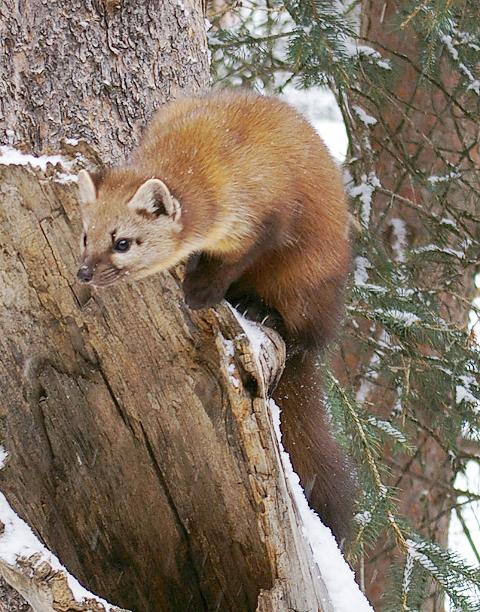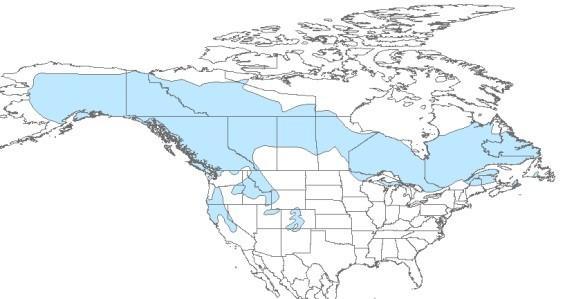 |
Canku Ota
|
 |
|
(Many Paths)
|
||
|
An Online Newsletter
Celebrating Native America
|
||
|
April 2020 - Volume
18 Number 4
|
||
|
|
||
|
American Marten
|
||
|
by University of Minnesota
- Duluth
|
||
Marten are largely nocturnal, medium-sized carnivores in the weasel family (Mustelidae). The major identification challenge is distinguishing marten from fishers, as they are found in similar habitat in trees and on the ground, and both have thick fur and bushy tails. Marten are much smaller than fishers and have orange on their throat and chest, which fishers lack. In addition, marten ears and snout appear pointier than fishers. Size: Total length averaged 24.2” (615 mm) in Minnesota, ranged from 23.6” to 26.6” (600-675 mm) in Wisconsin, and ranged from 21.7” to 25.6” (551-650 mm) in the Eastern United States. Tail length averaged 7.7” (195 mm) in Minnesota, ranged from 7.5” to 8.7” (190-220 mm) in Wisconsin, and ranged from 5.9” to 8.1” (150-205 mm) in the Eastern United States. Female body weight ranged from 1.5 to 2.2 pounds (0.7-1.0 kg) in Wisconsin, and from 1.3 to 1.8 pounds (0.6-0.8 kg) in the Eastern United States. Male body weight ranged from 2.2 to 3.1 pounds (1.0-1.4 kg) in Wisconsin, and from 2.4 to 2.9 pounds (1.1-1.3 kg) in the Eastern United States. Males are typically larger than females. Distribution & Status:
Worldwide, Martes americana is restricted to northern North America. Other Martes species occur throughout Europe and Asia. Marten have an IUCN rank of Least Concern, IUCN information. Life History: Reduced amounts of snow will affect marten distribution (Waltari and Guralnick, 2009). Deep snow gives the marten a competitive advantage over the fisher (M. pennanti) in winter periods (Raine, 1983; Krohn et al., 2004; Waltari and Guralnick, 2009). In montane areas, the marten is expected lose part of its lower elevation range and be more concentrated at higher elevations (Johnston et al., 2012). This loss is expected to reduce genetic diversity, connectivity of populations, and hinder the ability to disperse (Wasserman et al., 2013). Contacts with Humans: |
|||
|
|
||
|
|
||
| Canku Ota is a free Newsletter celebrating Native America, its traditions and accomplishments . We do not provide subscriber or visitor names to anyone. Some articles presented in Canku Ota may contain copyright material. We have received appropriate permissions for republishing any articles. Material appearing here is distributed without profit or monetary gain to those who have expressed an interest. This is in accordance with Title 17 U.S.C. Section 107. | ||
|
Canku Ota is a copyright ©
2000 - 2020 of Vicki Williams Barry and Paul Barry.
|
||
 |
 |
|
|
The "Canku
Ota - A Newsletter Celebrating Native America" web site and
its design is the
|
||
|
Copyright ©
1999 - 2020 of Paul C. Barry.
|
||
|
All Rights Reserved.
|
||

